《典范英语》(10_07)教学参考
四年级英语上册 Unit10(7)教案 苏教牛津版
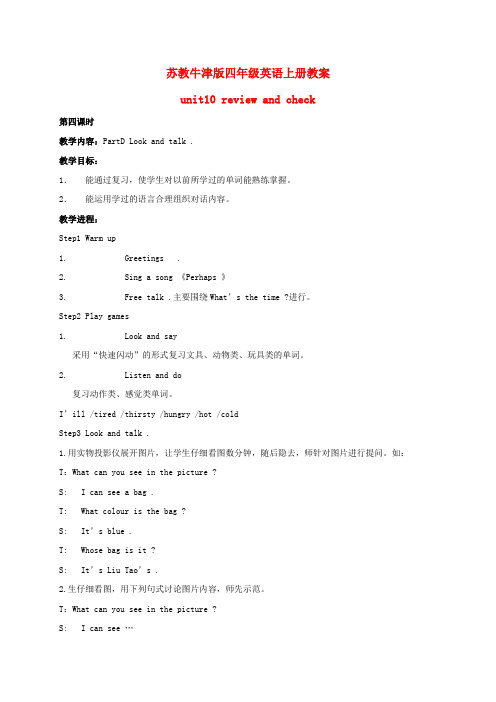
苏教牛津版四年级英语上册教案unit10 review and check第四课时教学内容:PartD Look and talk .教学目标:1.能通过复习,使学生对以前所学过的单词能熟练掌握。
2.能运用学过的语言合理组织对话内容。
教学进程:Step1 Warm up1. Greetings .2. Sing a song 《Perhaps 》3. Free talk .主要围绕What’s the time ?进行。
Step2 Play games1. Look and say采用“快速闪动”的形式复习文具、动物类、玩具类的单词。
2. Listen and do复习动作类、感觉类单词。
I’ill /tired /thirsty /hungry /hot /coldStep3 Look and talk .1.用实物投影仪展开图片,让学生仔细看图数分钟,随后隐去,师针对图片进行提问。
如:T:What can you see in the picture ?S: I can see a bag .T: What colour is the bag ?S: It’s blue .T: Whose bag is it ?S: It’s Liu Tao’s .2.生仔细看图,用下列句式讨论图片内容,师先示范。
T:What can you see in the picture ?S: I can see …T: Where is /are the…S: It’s /They’re …T: Whose … is it /are they?S: It’s /They’re …3.生自编对话表演。
师先示范,然后生在小组内练习。
Step 4 Do exercises .1. Look and write .1) Look at the dog .It’s nice .Whose dog is it?It’s Helen’s .2) Where are the gloves ?They’re on the bed .Step5 Goodbye .第五课时教学内容:做练习册教学目标:通过复习操练,让学生熟练掌握运用本学期所学的内容。
《典范英语》1aL10学习教学参考.docx
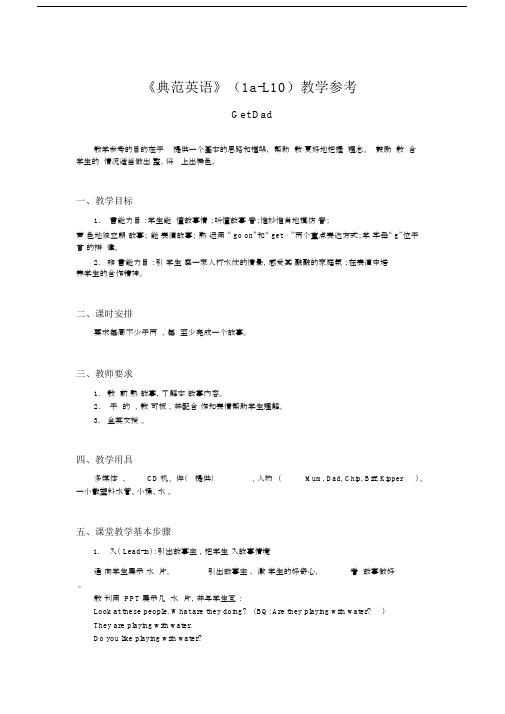
《典范英语》(1a-L10)教学参考Get Dad教学参考的目的在于提供一个基本的思路和框架,帮助教更好地把握理念。
鼓励教合学生的情况适当做出整,将上出特色。
一、教学目标1.言能力目:学生能懂故事情;听懂故事音;惟妙惟肖地模仿音;声色地独立朗故事;能表演故事;熟运用“ go on”和“ get ⋯”两个重点表达方式;学字母“ g”位于首的拼律。
2.非言能力目:引学生察一家人打水仗的情景,感受其融融的家庭氛;在表演中培养学生的合作精神。
二、课时安排要求每周不少于两,每至少完成一个故事。
三、教师要求1.教前熟故事,了解本故事内容。
2.于的,教可板,并配合作和表情帮助学生理解。
3.全英文授。
四、教学用具Mum, Dad, Chip, Biff, Kipper)、多媒体、CD机、件(提供)、人物(一小截塑料水管、小桶、水。
五、课堂教学基本步骤1.入( Lead-in):引出故事主,把学生入故事情境通向学生展示水片,引出故事主,激学生的好奇心,看故事做好。
教利用 PPT 展示几水片,并与学生互:Look at these people. What are they doing?(BQ: Are they playing with water?)They are playing with water.Do you like playing with water?Do you play a water game in summer?之后,自然过渡到讲故事环节:Kipper ’s family like playing with water. One day, they played a water game. How did they play? Let ’s learn the story.2.看图讲故事( Storytelling ):理解故事情节,观察一家人打水仗的情景教师利用课件逐幅播放故事图片,并用丰富的表情、生动的英文和适当的肢体语言给学生绘声绘色地讲故事,引导学生观察一家人打水仗的情景,充分感受他们的愉悦心情和其乐融融的家庭氛围。
新版典范英语7全文【范本模板】
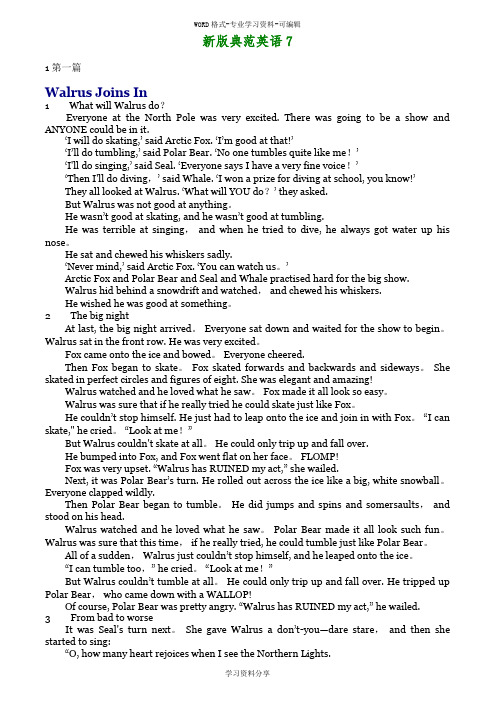
新版典范英语71 第一篇Walrus Joins In1What will Walrus do?Everyone at the North Pole was very excited. There was going to be a show and ANYONE could be in it.‘I will do skating,’ said Arctic Fox. ‘I’m good at that!’‘I’ll do tumbling,’ said Polar Bear. ‘No one tumbles quite like me!’‘I'll do singing,’ said Seal. ‘Everyone says I have a very fine voice!’‘Then I'll do diving,’ said Whale. ‘I won a prize for diving at school, you know!’They all looked at Walrus. ‘What will YOU do?’ they asked.But Walrus was not good at anything。
He wasn’t good at skating, and he wasn’t good at tumbling.He was terrible at singing,and when he tried to dive, he always got water up his nose。
He sat and chewed his whiskers sadly.‘Never mind,’ said Arctic Fox. ‘You can watch us。
’Arctic Fox and Polar Bear and Seal and Whale practised hard for the big show.Walrus hid behind a snowdrift and watched, and chewed his whiskers.He wished he was good at something。
《典范英语》1aL10教学参考

《模范英语》(1a-L10)教课参照Get Dad教课参照的目的在于供给一个基本的思路和框架,帮助教更好地掌握理念。
鼓舞教合学生的状况适合做出整,将上出特点。
一、教课目的1.言能力目:学生能懂故事情;听懂故事音;栩栩如生地模拟音;声色地独立朗故事;能表演故事;熟运用“ go on”和“ get ⋯”两个要点表达方式;学字母“ g”位于首的拼律。
2.非言能力目:引学生察一家人取水仗的情形,感觉其融融的家庭氛;在表演中培育学生的合作精神。
二、课时安排要求每周许多于两,每起码达成一个故事。
三、教师要求1.教前熟故事,认识本故事内容。
2.于的,教可板,并配合作和表情帮助学生理解。
3.全英文授。
四、教课器具多媒体、CD机、件(供给)、人物(Mum, Dad, Chip, Biff, Kipper)、一小截塑料水管、小桶、水。
五、讲堂教课基本步骤1.入( Lead-in):引出故事主,把学生入故事情境通向学生展现水片,引出故事主,激学生的好奇心,看故事做好。
教利用 PPT 展现几水片,并与学生互:Look at these people. What are they doing?(BQ: Are they playing with water?)They are playing with water.Do you like playing with water?Do you play a water game in summer?以后,自然过渡到讲故事环节:Kipper ’s family like playing with water. One day, they played a water game. How did they play? Let ’s learn the story.2.看图讲故事( Storytelling ):理解故事情节,察看一家人取水仗的情形教师利用课件逐幅播放故事图片,并用丰富的表情、生动的英文和适合的肢体语言给学生栩栩如生地讲故事,指引学生察看一家人取水仗的情形,充足感觉他们的欢乐心情和其乐滋滋的家庭气氛。
《典范英语》(5b-L17)教学参考
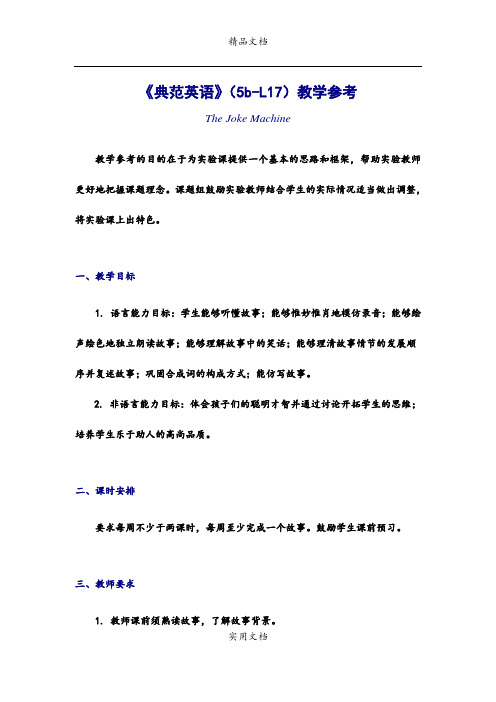
《典范英语》(5b-L17)教学参考The Joke Machine教学参考的目的在于为实验课提供一个基本的思路和框架,帮助实验教师更好地把握课题理念。
课题组鼓励实验教师结合学生的实际情况适当做出调整,将实验课上出特色。
一、教学目标1. 语言能力目标:学生能够听懂故事;能够惟妙惟肖地模仿录音;能够绘声绘色地独立朗读故事;能够理解故事中的笑话;能够理清故事情节的发展顺序并复述故事;巩固合成词的构成方式;能仿写故事。
2. 非语言能力目标:体会孩子们的聪明才智并通过讨论开拓学生的思维;培养学生乐于助人的高尚品质。
二、课时安排要求每周不少于两课时,每周至少完成一个故事。
鼓励学生课前预习。
三、教师要求1. 教师课前须熟读故事,了解故事背景。
嘿!嘿!嘿!(three cheers)源于19世纪初祝酒时人们会欢呼三遍Hip hip hooray!呼喊的形式不一样,表达的意思也不一样。
一个人喊是表达内心的欢乐,一群人喊则表示为某人欢呼。
通常由一个人提议为某人欢呼三次,他喊“Hip hip”,其他的人回应“Hooray!”。
如此连喊三遍。
纸牌游戏 (snap)Snap是一种简单的扑克牌游戏。
参加者把牌分成几叠,轮流亮牌,在出现相同点数或相同头像的两张牌时,先喊snap的人赢得整叠牌。
在故事里Nadim 问大家鳄鱼最喜欢玩什么纸牌游戏?这个问题其实是脑筋急转弯,一语双关。
Snap一方面指纸牌游戏,一方面表示鳄鱼咔嚓一口把人咬成两断。
2. 对于较难的单词,教师可板书,并配合动作和表情帮助学生理解。
3. 全英文授课。
四、教学用具多媒体设备、CD机、课件(课题组提供)、谜语卡片(谜面和谜底)、句子卡片(见复述故事环节)。
五、课堂教学基本步骤1. 导入(Lead-in):讲笑话,引入故事通过给学生讲几个小笑话,展开对“joke”的讨论,为看图讲故事做好铺垫。
教师提出以下问题,与学生互动,并自然过渡到讲故事环节:Do you like jokes?Listen to me carefully and guess what it is.What has many keys but can’t open any doors? (A piano)What letter of the alphabet is a part of the head? (I.)What letter is a drink? (T. )Look at the title of the new story. Do you know what a joke machine is? Let’s find it out in the story.2. 听录音模仿(Listening and Imitating):听懂录音并了解孩子们讲的笑话教师播放故事图片1-9的录音,引导学生听录音,了解故事背景。
典范英语7复习教案及练习
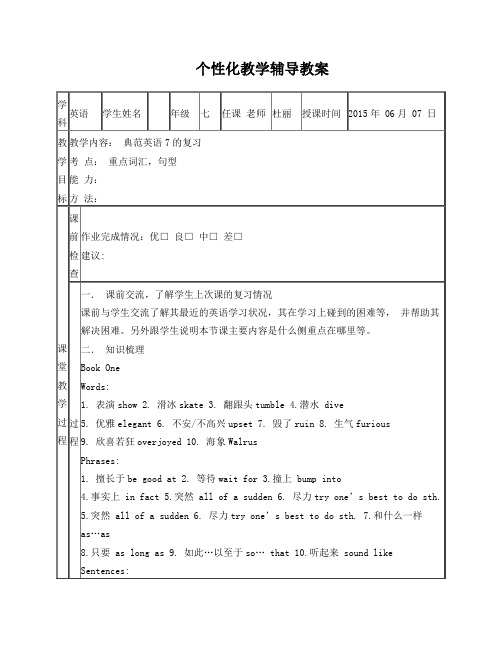
个性化教学辅导教案A. Bill has a pen pal in the USA.B. Lisa lives in New York.C. Bill can play the piano and Lisa can play the guitar.D. Bill and Lisa like different sports.B26. We can learn to play ping-pong .A. at Mr Cai’s houseB. on Friday afternoonC. in School’s P.E. BuildingD. from Monday to Friday27. The Star Rock Band will meet every .A. Friday afternoonB. Monday morningC. Saturday afternoonD. Sunday morning28. Cathy can sing well and she wants to meet some music lovers. She can______ .A. call 368-5788B. call 898-3343C. meet Mr. Cai on SundayD. meet Tina on SaturdayCBill and his friends are in a big city. He takes a lot of food. His bag is big and heavy. Soon, Bill gets lost. He walks in the street for a long time and he feels tired (疲惫). It’s eight in the evening, he g oes into a restaurant. He asks for some drinks and soon he begins to sleep. When he wakes up (醒来),he can’t find any people in the restaurant. The door is closed and he can’t go out. He finds a telephone number and begins to call Mt Jackson, the owner (主人) of the restaurant.“Hello,” says the boy. “When do you open your restaurant, Mr. Jackson?”The telephone wakes up the man and he isn’t happy. So he says, “Don’t ask me about that. I can’t let you in.”“Oh, no! I want to go out.”29. Bill’s bag is bi g because _________.A. there’s a lot of clothes in itB. he puts much food in itC. he likes big bagsD. he takes manybooks30. Bill goes to sleep because .A. he gets homeB.he eats too much in the restaurantC. he doesn’t know where he can goD. he’s very tired31. Mr. Jackson thinks_____________.A. Bill wants to sleep in his restaurantB. Bill wants to go into the restaurantC. Bill leaves his bag in the restaurantD. Bill wants to go out of the restaurantDToby, an 11-year-old boy, is playing with a ball. The ball goes into the street and Toby runs for the ball. A car hit(碰撞) Toby.An ambulance(救护车)takes Toby to the hospital in 30 minutes. The doctors a t the hospital tell Toby’s parents, “Toby is in a coma.” Every day Toby’s parents visit him at the hospital. They sit next to Toby’s bed and talk to him. But Toby never talks to them. He just sleeps.One day, Toby’s father says ,” Wake up, Toby. Wakeup, come home and play with Rusty.” Rusty is Toby’s dog.When Toby’s father says ’Rusty’, Toby moves his arm. “Rusty!” Toby’s father says again. Again, Toby moves his arm(手臂).Toby’s parents have an idea. They tell the nurse, “We want to bring Toby’s dog to the hospital.” The nurse says “OK”.The next day, Toby’s parents bring Rusty to the hospital. When they put the dog on Toby’s bed, Toby opens his eyes and hugs(拥抱)the dog.Toby’s parents bring Rusty to the hospital every day. One day Rusty jumps ont o Toby’s bed and scratches(抓)his arms. Toby says his firstwords“Bad dog!”.After eight weeks, Toby is well. He leaves the hospital and goes home.32. Toby is in the street when a car hits him.A. visiting his fatherB. walking with his dogC. talking with his dogD. running for a ball33. The words “Toby is in a coma.” may mean (意思是)_____________.[来源:]A .Toby can’t wake up or talk B. Toby must leave thehospitalC. Toby needs to play sportsD. Toby is very healthy34. wakes up Toby in the bed.A. A doctorB. A nurseC. His dogD. His father35. From the story, we can learn that .A. Toby can never talk at lastB. Toby likes playing basketballC. Toby’s dog is badD. Toby is in hospital for about eight weeks36. The best title(标题)for the story may be .A. the parents’ loveB. Toby and RustyC. a story of RustyD. Toby’s family5.课堂小结这节主要复习了book one 的知识点及一些练习,通过今天的学习,希望学生能够掌握所学知识巩固所学内容。
《典范英语》(3a-L30)教学参考
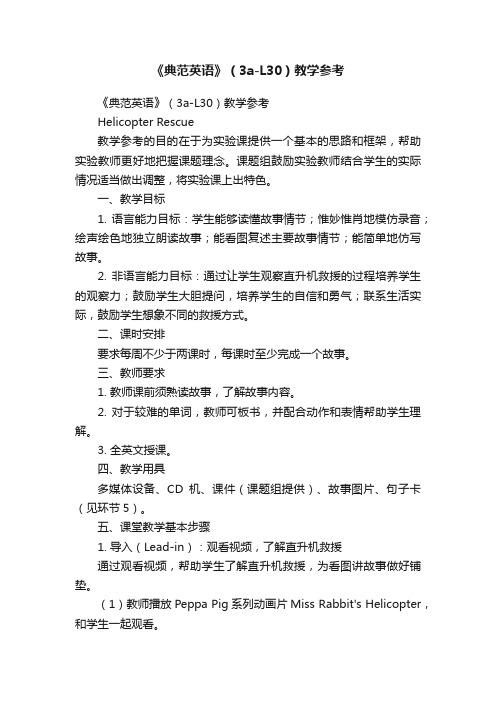
《典范英语》(3a-L30)教学参考《典范英语》(3a-L30)教学参考Helicopter Rescue教学参考的目的在于为实验课提供一个基本的思路和框架,帮助实验教师更好地把握课题理念。
课题组鼓励实验教师结合学生的实际情况适当做出调整,将实验课上出特色。
一、教学目标1. 语言能力目标:学生能够读懂故事情节;惟妙惟肖地模仿录音;绘声绘色地独立朗读故事;能看图复述主要故事情节;能简单地仿写故事。
2. 非语言能力目标:通过让学生观察直升机救援的过程培养学生的观察力;鼓励学生大胆提问,培养学生的自信和勇气;联系生活实际,鼓励学生想象不同的救援方式。
二、课时安排要求每周不少于两课时,每课时至少完成一个故事。
三、教师要求1. 教师课前须熟读故事,了解故事内容。
2. 对于较难的单词,教师可板书,并配合动作和表情帮助学生理解。
3. 全英文授课。
四、教学用具多媒体设备、CD机、课件(课题组提供)、故事图片、句子卡(见环节5)。
五、课堂教学基本步骤1. 导入(Lead-in):观看视频,了解直升机救援通过观看视频,帮助学生了解直升机救援,为看图讲故事做好铺垫。
(1)教师播放Peppa Pig系列动画片Miss Rabbit's Helicopter,和学生一起观看。
(2)展示图片,并结合动画内容提问,引入故事情境:Look! What’s this?(展示一张直升机的图片)It’s a helicopter.What’s the helicopter for?(展示一张正在救援的直升机)It’s for rescue. So we call it a rescue helicopter.Who had a rescue helicopter in the video?Miss Rabbit had a rescue helicopter.What did the helicopter rescue?It rescued Daddy Pig’s car.One day, the children saw a rescue helicopter. What did it rescue? Let’s learn the story Helicopter Rescue.2. 看图讲故事(Storytelling):理解故事情节,观察直升机救援的过程教师利用课件逐幅播放故事图片,并用丰富的表情、生动的英文和适当的肢体语言给学生绘声绘色地讲故事,让学生观察直升机救援的过程。
典范英语7-10精灵简姆斯同撞击事件 (1)
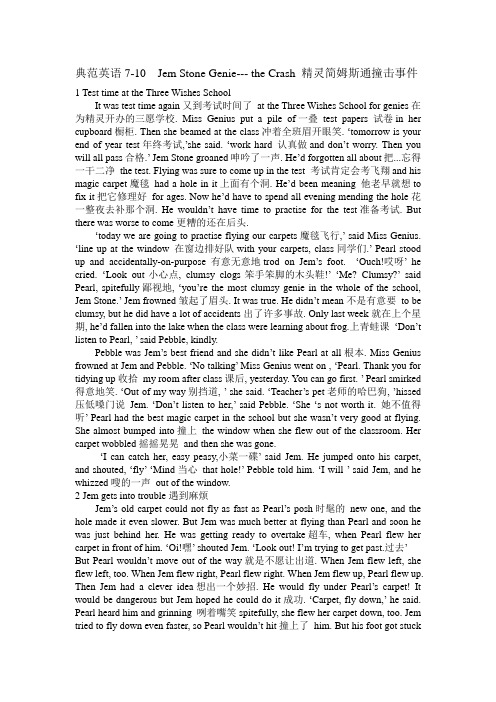
典范英语7-10 Jem Stone Genie--- the Crash 精灵简姆斯通撞击事件1 Test time at the Three Wishes SchoolIt was test time again又到考试时间了at the Three Wishes School for genies在为精灵开办的三愿学校. Miss Genius put a pile of一叠test papers 试卷in her cupboard橱柜. Then she beamed at the class冲着全班眉开眼笑. ‘tomorrow is your end of year test年终考试,’she said. ‘work hard 认真做and don’t worry. Then you will all pass合格.’ Jem Stone groaned呻吟了一声. He’d forgotten all about把...忘得一干二净the test. Flying was sure to come up in the test 考试肯定会考飞翔and his magic carpet魔毯had a hole in it上面有个洞. He’d been meaning 他老早就想to fix it把它修理好for ages. Now he’d have to spend all evening mending the hole花一整夜去补那个洞. He wouldn’t have time to practise for the test准备考试. But there was worse to come更糟的还在后头.‘today we are going to practise flying our carpets魔毯飞行,’ said Miss Genius. ‘line up at the window 在窗边排好队with your carpets, class同学们.’ Pearl stood up and accidentally-on-purpose 有意无意地trod on Jem’s foot. ‘Ouch!哎呀’he cried. ‘Look out小心点, clumsy clogs笨手笨脚的木头鞋!’‘Me? Clumsy?’said Pearl, spitefully鄙视地, ‘you’re the most clumsy genie in the whole of the school, Jem Stone.’ Jem frowned皱起了眉头. It was true. He didn’t mean不是有意要to be clumsy, but he did have a lot of accidents出了许多事故. Only last week就在上个星期, he’d fallen into the lake when the class were learning about frog.上青蛙课‘Don’t listen to Pearl, ’ said Pebble, kindly.Pebble was Jem’s best friend and she didn’t like Pearl at all根本. Miss Genius frowned at Jem and Pebble. ‘No talking’ Miss Genius went on , ‘Pearl. Thank you for tidying up收拾my room after class课后, yesterday. You can go first. ’ Pearl smirked 得意地笑. ‘Out of my way别挡道, ’ she said. ‘Teacher’s pet老师的哈巴狗, ’hissed 压低嗓门说Jem. ‘Don’t listen to her,’ said Pebble. ‘She ‘s not worth it. 她不值得听’ Pearl had the best magic carpet in the school but she wasn’t very good at flying. She almost bumped into撞上the window when she flew out of the classroom. Her carpet wobbled摇摇晃晃and then she was gone.‘I can catch her, easy peasy,小菜一碟’said Jem. He jumped onto his carpet, and shouted, ‘fly’‘Mind当心that hole!’ Pebble told him. ‘I will ’ said Jem, and he whizzed嗖的一声out of the window.2 Jem gets into trouble遇到麻烦Jem’s old carpet could not fly as fast as Pearl’s posh时髦的new one, and the hole made it even slower. But Jem was much better at flying than Pearl and soon he was just behind her. He was getting ready to overtake超车, when Pearl flew her carpet in front of him. ‘Oi!嘿’ shouted Jem. ‘Look out! I’m trying to get past.过去’But Pearl wouldn’t move out of the way就是不愿让出道. When Jem flew left, she flew left, too. When Jem flew right, Pearl flew right. When Jem flew up, Pearl flew up. Then Jem had a clever idea想出一个妙招. He would fly under Pearl’s carpet! It would be dangerous but Jem hoped he could do it成功. ‘Carpet, fly down,’ he said. Pearl heard him and grinning 咧着嘴笑spitefully, she flew her carpet down, too. Jem tried to fly down even faster, so Pearl wouldn’t hit撞上了him. But his foot got stuckin卡在里面the hole. He tried and tried to tug it free把它拔出来and the carpet wobbled closer and closer to Pearl.BANG! The two carpets crashed撞上了. Then Jem and his carpet began to fall. Jem could see Miss Genius standing on the playground. He tried to move the carpet out of her way驶离她那边but the hole was making it very hard to steer控制方向. Miss Genius was a bit deaf有点聋and she hadn’t noticed Jem was about to fall on her head.Jem did some fast thinking快速地想办法. Spells were against the school rules 说魔咒是违法学校规定的. He would be in big trouble if Miss Stick, the head teacher, found out. But he had to do something, or he would crash onto 撞上Miss Genius. ‘Carpet,’ Jem wished, ‘Please land着陆beside her, As soft as a spider蜘蛛.’There was another bang and a cloud of green smoke一团绿烟. Jem landed with a bump砰的一声着陆. Something small ran over跑过his hand and then scuttled away 匆匆而逃. Pebble helped him up 帮忙扶起他and she looked very upset沮丧. ‘what did you do that for你为什么那么做?’ she cried. ‘why did you turn Miss Genius into 把..变成 a spider?’‘i didn’t’ said Jem, hotly急切地. ‘you did.’‘didn’t.’‘did’‘didn’t , didn’t didn’t, i wished for my carpet to land beside her, ’ said Jem. ‘Well it sounded as if 听起来好像you wished our teacher into a spider希望把我们的老师变成, and now she is one.’ said Pebble. ‘Poor Miss Genius. Turn her back again把她变回来, quickly!’‘i’m trying to!’ cried Jem. He knew he had to act very fast. Miss Genius mustn’t find out that he had used a spell on her. If she found out that Jem had turned her into a spider she would be very cross. She might not let him take the test tomorrow. That would be awful. Jem would have to stay in the beginner’s class for another year. But as Jem began the spell, the school cat came running towards them. His green eyes were lit up like lamps.‘It’s Claws!’ cried Pebble. ‘Quick, Jem, he’s after the spider. He mustn’t catch Miss Genius!’ Jem tried to grab the cat, but he slipped though Jem’s finger.3 Where is Miss Genius?Jem and Pebble raced after the cat as he headed across the playground after the spider. The cat was quick but the spider was quicker. It scuttled across the playground and into the school. Then it slipped under the door of the girls’ room. The cat spat, crossly, and put his paw under the door. ‘Oh, no, you don’t !’ cried Jem. He picked the cat up and took him back to the playground. Then he shut the school door so that the cat couldn’t get back inside and ran back to the girls’ room. Pebble was waiting for him. ‘She’s under there,’ said Pebble, pointing to a small cupboard. ‘look, you can just see one of her legs. ’ Jem picked up a glass and handed it to Pebble. ‘i’m going to move the cupboard. Put this glass over the spider to stop her running away again. It won’t hurt her.’All of a sudden, the door burst open. Pearl came in followed by the rest of the class. ‘Get away from my things, Jem Stone,’ she yelled. ‘don’t be silly, Pearl,’ said Pebble. ‘Jem is only trying to catch Miss Genius.’‘it’s my cupboard. I’ll catch her,’said Pearl, angrily. ‘Come away from my things or i’ll tell Miss Stick, the head teacher, what you did to Miss Genius. She’ll throw you out of school, Jem Stone. Youknow it’s against the rules to do spells on the teachers.’‘Oh, go away!’ said Pebble. She pushed Pearl out of the room and locked the door. ‘you can’t lock me out of the girls’ room!’ yelled Pearl and she rattled the door handle. ‘i’m going to get Miss Stick. Then you’ll be sorry.’Pebble looked worried. ‘hurry up, Jem, we haven’t got much time.’ Jem pushed the cupboard very carefully. A piece of paper fluttered out from under it. ‘can you see the spider?’ he asked. “No,” said Pebble. Jem pushed the cupboard again. ‘There she is!’yelled Pebble, excitedly. ‘Move it again, Jem.’Jem moved the cupboard again. Pebble lifted up the glass and put it carefully over the spider. ‘Got her’ cried Pebble.Everybody in the room cheered. Jem raced over to Pebble. He was in such a hurry to turn the spider back into Miss Genius that he tripped and crashed into Pebble. ‘Look out’ Pebble cried. She was still holding the glass against the floor. ‘Sorry’ said Jem, and he started to make a new spell. ‘spider, goodbye, Miss Genius, hi’There was a loud POP and a cloud of green smoke. When it cleared, Miss Genius was back to herself. Well, almost. She was sitting on the floor with a glass on her head.4 Miss Genius has a surpriseAll of a sudden, there was a bang on the door. It sounded angry. ‘let me in’shouted the head teacher. Jem opened the door. He knew he was in very big trouble now. Miss Stick sounded very cross. Pearl was with her, looking smug. ‘there he is ’she said. ‘in the grils’ room, and poor Miss Genius...’Pearl stopped and stared at her teacher in surprise. Miss Genius was holding up a piece of paper. ‘what was this doing under your cupboard, Pearl?’ she asked. ‘I...I...’For once, Pearl was lost for words. ‘This is a copy of tomorrow’s test paper,’ went on Miss Genius. ‘when did you take it? Was it when you tidied up my room after school, yesterday? And i thought you were being helpful!’Miss Stick took the test paper from Miss Genius. She looked very cross. ‘Does this mean you were going to cheat, Pearl Gates?’ she said. ‘Come to my office!’She turned to Miss Genius and said, ‘Pearl cannot take the end of year test, now. She will have to stay in the beginners’ class.’Miss Stick marched from the room with Pearl following her. Nobody said anything for a moment and then Miss Genius smiled. ‘Class is over. You can use the rest of the day to practise for the test.’‘yes ’shouted everybody. ‘thanks, Miss Genius.’‘You can thank me by getting top marks, tomorrow.’ said Miss Genius. ‘And Jem, you must be very careful with your spells. You know, i might accidentally turn you into a fly.’ Everybody laughed and Jem laughed too. He was glad he wasn’t in trouble for因为turning Miss Genius into a spider. ‘Come on,’ said Pebble, taking Jem’s arm 拉着简姆的胳膊. ‘let’s go and practise for our test. ’‘Later先别急,’said Jem, heading for the door. ‘But first of all首先, i’ve got a hole in my carpet that needs fixing.’。
《典范英语》(1b-L10) 教学参考
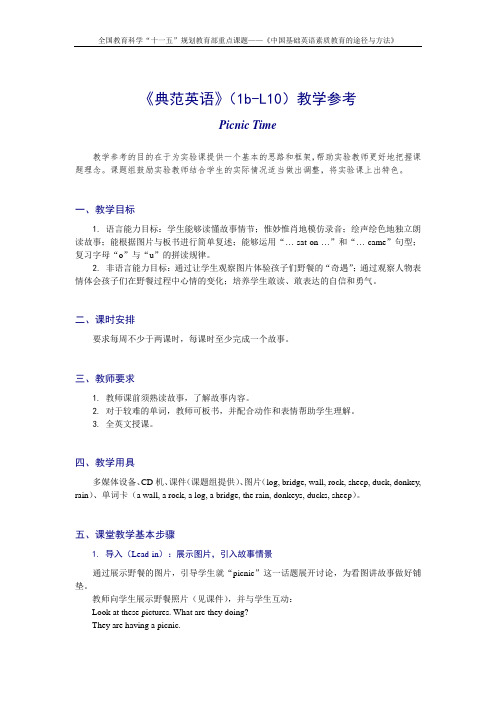
《典范英语》(1b-L10)教学参考Picnic Time教学参考的目的在于为实验课提供一个基本的思路和框架,帮助实验教师更好地把握课题理念。
课题组鼓励实验教师结合学生的实际情况适当做出调整,将实验课上出特色。
一、教学目标1. 语言能力目标:学生能够读懂故事情节;惟妙惟肖地模仿录音;绘声绘色地独立朗读故事;能根据图片与板书进行简单复述;能够运用“… sat on …”和“… came”句型;复习字母“o”与“u”的拼读规律。
2. 非语言能力目标:通过让学生观察图片体验孩子们野餐的“奇遇”;通过观察人物表情体会孩子们在野餐过程中心情的变化;培养学生敢读、敢表达的自信和勇气。
二、课时安排要求每周不少于两课时,每课时至少完成一个故事。
三、教师要求1.教师课前须熟读故事,了解故事内容。
2.对于较难的单词,教师可板书,并配合动作和表情帮助学生理解。
3.全英文授课。
四、教学用具多媒体设备、CD机、课件(课题组提供)、图片(log, bridge, wall, rock, sheep, duck, donkey, rain)、单词卡(a wall, a rock, a log, a bridge, the rain, donkeys, ducks, sheep)。
五、课堂教学基本步骤1. 导入(Lead-in):展示图片,引入故事情景通过展示野餐的图片,引导学生就“picnic”这一话题展开讨论,为看图讲故事做好铺垫。
教师向学生展示野餐照片(见课件),并与学生互动:Look at these pictures. What are they doing?They are having a picnic.Do you often have a picnic?Where do you often have a picnic?What do you take for a picnic?展示故事标题(见课件),引入故事情境:Kipper’s family went to a picnic. Where did they go? What happened to the children? Let’s learn the story.2. 看图讲故事(Storytelling):理解故事情节,了解孩子们野餐时的“奇遇”,体会他们的心情变化教师利用课件逐幅播放故事图片,并用丰富的表情、生动的英文和适当的肢体语言给学生绘声绘色地讲故事,让学生观察图片,了解孩子们野餐时到过的地方和遇到的动物,体会孩子们的情绪变化。
典范英语参考7_04 哦,奥托!
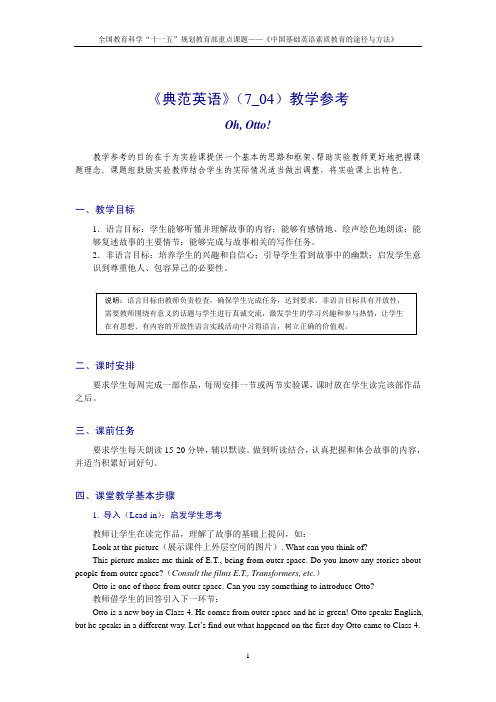
《典范英语》(7_04)教学参考Oh, Otto!教学参考的目的在于为实验课提供一个基本的思路和框架,帮助实验教师更好地把握课题理念。
课题组鼓励实验教师结合学生的实际情况适当做出调整,将实验课上出特色。
一、教学目标1.语言目标:学生能够听懂并理解故事的内容;能够有感情地、绘声绘色地朗读;能够复述故事的主要情节;能够完成与故事相关的写作任务。
2.非语言目标:培养学生的兴趣和自信心;引导学生看到故事中的幽默;启发学生意识到尊重他人、包容异己的必要性。
说明:语言目标由教师负责检查,确保学生完成任务,达到要求。
非语言目标具有开放性,需要教师围绕有意义的话题与学生进行真诚交流,激发学生的学习兴趣和参与热情,让学生在有思想、有内容的开放性语言实践活动中习得语言,树立正确的价值观。
二、课时安排要求学生每周完成一部作品,每周安排一节或两节实验课,课时放在学生读完该部作品之后。
三、课前任务要求学生每天朗读15-20分钟,辅以默读。
做到听读结合,认真把握和体会故事的内容,并适当积累好词好句。
四、课堂教学基本步骤1. 导入(Lead-in):启发学生思考教师让学生在读完作品,理解了故事的基础上提问,如:Look at the picture(展示课件上外层空间的图片). What can you think of?This picture makes me think of E.T., being from outer space. Do you know any stories about people from outer space?(Consult the films E.T., Transformers, etc.)Otto is one of those from outer space. Can you say something to introduce Otto?教师借学生的回答引入下一环节:Otto is a new boy in Class 4. He comes from outer space and he is green! Otto speaks English, but he speaks in a different way. Let’s find out what happened on the first day Otto came to Class 4.2. 朗读(Reading aloud):朗读与思考相结合(1)检查学生朗读。
《典范英语》(1b-L5)教学参考
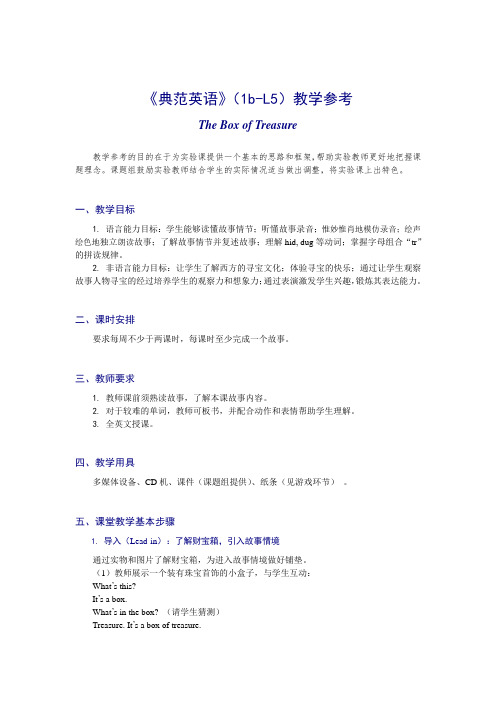
《典范英语》(1b-L5)教学参考The Box of Treasure教学参考的目的在于为实验课提供一个基本的思路和框架,帮助实验教师更好地把握课题理念。
课题组鼓励实验教师结合学生的实际情况适当做出调整,将实验课上出特色。
一、教学目标1.语言能力目标:学生能够读懂故事情节;听懂故事录音;惟妙惟肖地模仿录音;绘声绘色地独立朗读故事;了解故事情节并复述故事;理解hid, dug等动词;掌握字母组合“tr”的拼读规律。
2. 非语言能力目标:让学生了解西方的寻宝文化;体验寻宝的快乐;通过让学生观察故事人物寻宝的经过培养学生的观察力和想象力;通过表演激发学生兴趣,锻炼其表达能力。
二、课时安排要求每周不少于两课时,每课时至少完成一个故事。
三、教师要求1.教师课前须熟读故事,了解本课故事内容。
2.对于较难的单词,教师可板书,并配合动作和表情帮助学生理解。
3.全英文授课。
四、教学用具多媒体设备、CD机、课件(课题组提供)、纸条(见游戏环节)。
五、课堂教学基本步骤1. 导入(Lead-in):了解财宝箱,引入故事情境通过实物和图片了解财宝箱,为进入故事情境做好铺垫。
(1)教师展示一个装有珠宝首饰的小盒子,与学生互动:What’s this?It’s a box.What’s in the box? (请学生猜测)Treasure. It’s a box of treasure.(2)展示故事第一幅图,过渡到看图讲故事环节:One day, the family went to the beach. They played a game “Treasure Hunt”(寻宝). What treasure did Mum and Dad have? Would the children find the treasure? Let’s have a look.2. 看图讲故事(Storytelling):理解故事情节,观察寻宝的经过教师利用课件逐幅播放故事图片,并用丰富的表情、生动的英文和适当的肢体语言给学生绘声绘色地讲故事,引导学生从故事图片中观察故事情节的发展,体会孩子们寻宝的趣味性。
《典范英语》(1a-L7)教学参考
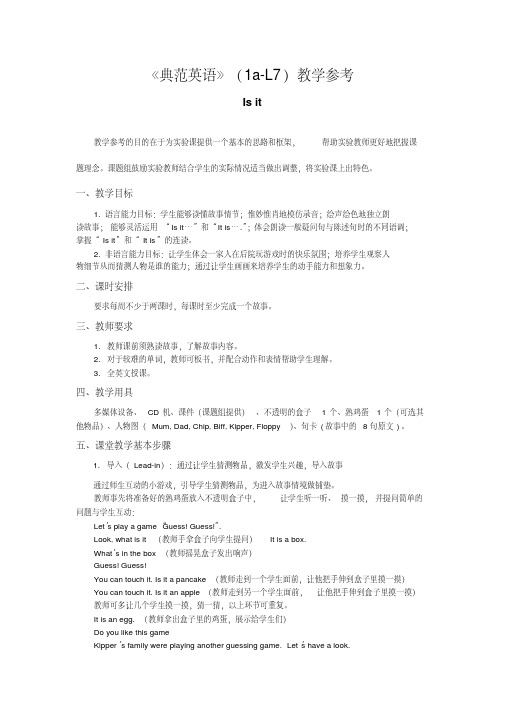
《典范英语》(1a-L7)教学参考Is it教学参考的目的在于为实验课提供一个基本的思路和框架,帮助实验教师更好地把握课题理念。
课题组鼓励实验教师结合学生的实际情况适当做出调整,将实验课上出特色。
一、教学目标1. 语言能力目标:学生能够读懂故事情节;惟妙惟肖地模仿录音;绘声绘色地独立朗读故事;能够灵活运用“Is it…”和“It is….”;体会朗读一般疑问句与陈述句时的不同语调;掌握“Is it”和“It is”的连读。
2. 非语言能力目标:让学生体会一家人在后院玩游戏时的快乐氛围;培养学生观察人物细节从而猜测人物是谁的能力;通过让学生画画来培养学生的动手能力和想象力。
二、课时安排要求每周不少于两课时,每课时至少完成一个故事。
三、教师要求1. 教师课前须熟读故事,了解故事内容。
2.对于较难的单词,教师可板书,并配合动作和表情帮助学生理解。
3. 全英文授课。
四、教学用具多媒体设备、CD机、课件(课题组提供)、不透明的盒子1个、熟鸡蛋1个(可选其他物品)、人物图(Mum, Dad, Chip, Biff, Kipper, Floppy)、句卡(故事中的8句原文)。
五、课堂教学基本步骤1. 导入(Lead-in):通过让学生猜测物品,激发学生兴趣,导入故事通过师生互动的小游戏,引导学生猜测物品,为进入故事情境做铺垫。
教师事先将准备好的熟鸡蛋放入不透明盒子中,让学生听一听、摸一摸,并提问简单的问题与学生互动:Let’s play a game “Guess! Guess!”.Look, what is it (教师手拿盒子向学生提问)It is a box.What’s in the box (教师摇晃盒子发出响声)Guess! Guess!You can touch it. Is it a pancake (教师走到一个学生面前,让他把手伸到盒子里摸一摸)You can touch it. Is it an apple (教师走到另一个学生面前,让他把手伸到盒子里摸一摸)教师可多让几个学生摸一摸,猜一猜,以上环节可重复。
《典范英语》(10_07)教学参考
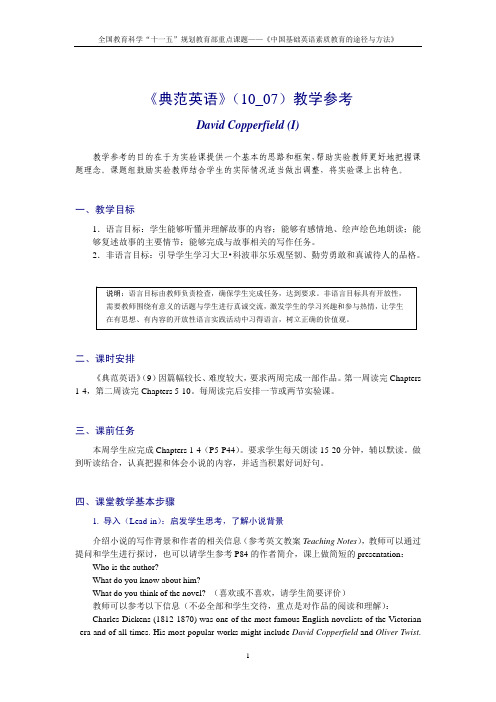
《典范英语》(10_07)教学参考David Copperfield (I)教学参考的目的在于为实验课提供一个基本的思路和框架,帮助实验教师更好地把握课题理念。
课题组鼓励实验教师结合学生的实际情况适当做出调整,将实验课上出特色。
一、教学目标1.语言目标:学生能够听懂并理解故事的内容;能够有感情地、绘声绘色地朗读;能够复述故事的主要情节;能够完成与故事相关的写作任务。
2.非语言目标:引导学生学习大卫•科波菲尔乐观坚韧、勤劳勇敢和真诚待人的品格。
说明:语言目标由教师负责检查,确保学生完成任务,达到要求。
非语言目标具有开放性,需要教师围绕有意义的话题与学生进行真诚交流,激发学生的学习兴趣和参与热情,让学生在有思想、有内容的开放性语言实践活动中习得语言,树立正确的价值观。
二、课时安排《典范英语》(9)因篇幅较长、难度较大,要求两周完成一部作品。
第一周读完Chapters 1-4,第二周读完Chapters 5-10。
每周读完后安排一节或两节实验课。
三、课前任务本周学生应完成Chapters 1-4(P5-P44)。
要求学生每天朗读15-20分钟,辅以默读。
做到听读结合,认真把握和体会小说的内容,并适当积累好词好句。
四、课堂教学基本步骤1. 导入(Lead-in):启发学生思考,了解小说背景介绍小说的写作背景和作者的相关信息(参考英文教案Teaching Notes),教师可以通过提问和学生进行探讨,也可以请学生参考P84的作者简介,课上做简短的presentation:Who is the author?What do you know about him?What do you think of the novel? (喜欢或不喜欢,请学生简要评价)教师可以参考以下信息(不必全部和学生交待,重点是对作品的阅读和理解):Charles Dickens (1812-1870) was one of the most famous English novelists of the Victorian era and of all times. His most popular works might include David Copperfield and Oliver Twist.Dickens had a miserable childhood. His father was sent to prison since he was at the age of 9 and then at the age of 12 he was sent to work in a factory under poor conditions. After three years of hard work, he returned to school, but it was a school just as horrible as Mr Creakle’s Establishment in David Copperfield.David Copperfield is a famous novel first published in 1850. Many elements of the book are based on its author Charles Dickens’ life and the book is probably the most autobiographical of all his works. The story is set in early Victorian England against a backdrop of great social change. The industrial revolution had transformed the social structure of the country and the gap between the rich and the poor increased. People moved to the city in search of opportunities and endured poverty and dirty, crowded living conditions. Besides, many children were forced to work long hours.2. 复述(Retelling):关注内容与语言表达的准确性,锻炼学生连贯表达思想的能力了解背景后,让学生分组完成复述任务。
《典范英语》(3a-L17)教学参考
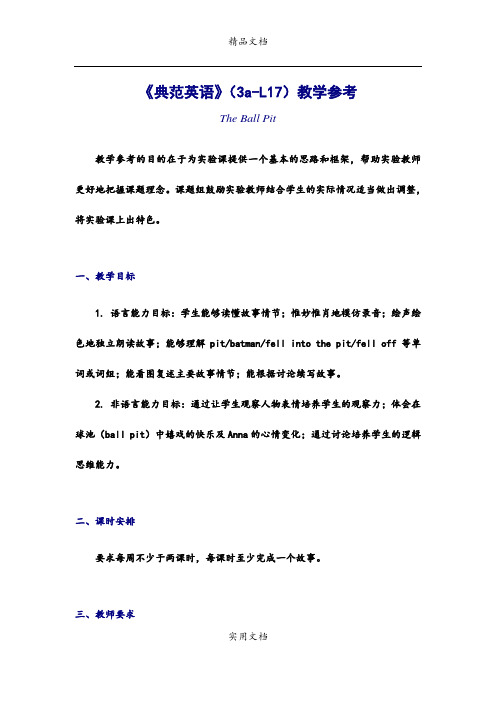
《典范英语》(3a-L17)教学参考The Ball Pit教学参考的目的在于为实验课提供一个基本的思路和框架,帮助实验教师更好地把握课题理念。
课题组鼓励实验教师结合学生的实际情况适当做出调整,将实验课上出特色。
一、教学目标1. 语言能力目标:学生能够读懂故事情节;惟妙惟肖地模仿录音;绘声绘色地独立朗读故事;能够理解pit/batman/fell into the pit/fell off等单词或词组;能看图复述主要故事情节;能根据讨论续写故事。
2. 非语言能力目标:通过让学生观察人物表情培养学生的观察力;体会在球池(ball pit)中嬉戏的快乐及Anna的心情变化;通过讨论培养学生的逻辑思维能力。
二、课时安排要求每周不少于两课时,每课时至少完成一个故事。
三、教师要求1. 教师课前须熟读故事,了解故事内容。
2. 对于较难的单词,教师可板书,并配合动作和表情帮助学生理解。
3. 全英文授课。
四、教学用具多媒体设备、CD机、课件(课题组提供)、故事图片(第9幅图)。
五、课堂教学基本步骤1. 导入(Lead-in):观看视频,了解ball pit通过观看视频和提问,让学生联系实际生活,了解ball pit,为看图讲故事做好铺垫。
教师播放视频短片The Ball Pit(见课件):Now we are going to watch a video clip. It is called The Ball Pit.播放完后,教师就短片内容与学生互动:What can you see in the ball pit?Is it fun to play in the ball pit?Do you like to play in the ball pit?之后,自然过渡到讲故事环节:Last weekend, Mum took Kipper and hisfriend Anna to the ball pit. Did they have fun? What happened in the story? Let’s read the story The Ball Pit.2. 看图讲故事(Storytelling):理解故事情节,观察孩子们在ball pit 嬉戏的情景教师利用课件逐幅播放故事图片,并用丰富的表情、生动的英文和适当的肢体语言给学生绘声绘色地讲故事,让学生观察孩子们在ball pit嬉戏的情景,体会Anna的心情变化。
《典范英语》(4b-L7)教学参考
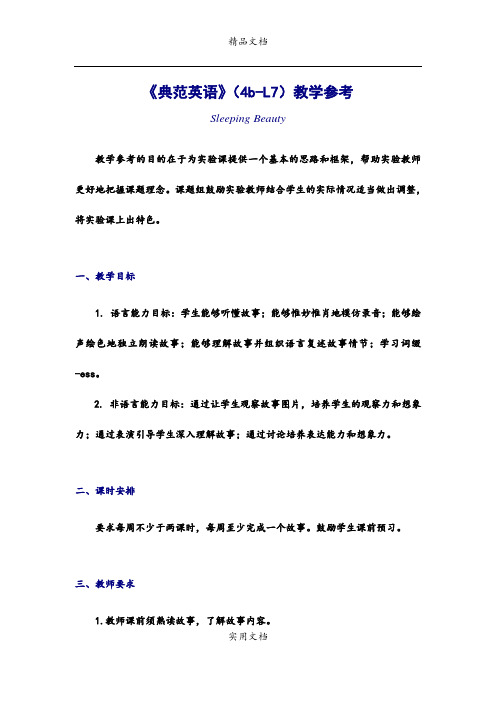
《典范英语》(4b-L7)教学参考Sleeping Beauty教学参考的目的在于为实验课提供一个基本的思路和框架,帮助实验教师更好地把握课题理念。
课题组鼓励实验教师结合学生的实际情况适当做出调整,将实验课上出特色。
一、教学目标1. 语言能力目标:学生能够听懂故事;能够惟妙惟肖地模仿录音;能够绘声绘色地独立朗读故事;能够理解故事并组织语言复述故事情节;学习词缀-ess。
2. 非语言能力目标:通过让学生观察故事图片,培养学生的观察力和想象力;通过表演引导学生深入理解故事;通过讨论培养表达能力和想象力。
二、课时安排要求每周不少于两课时,每周至少完成一个故事。
鼓励学生课前预习。
三、教师要求1.教师课前须熟读故事,了解故事内容。
2. 对于较难的单词,教师可板书,并配合动作和表情帮助学生理解。
3. 全英文授课。
四、教学用具多媒体设备、CD机、课件(课题组提供)、故事图片(见检查理解环节)。
五、课堂教学基本步骤1. 导入(Lead-in):观看视频,引出故事主题通过观看视频,引出故事主题睡美人。
(1)播放视频片段,并与学生进行互动:Who were the boy and the girl?What had happened to the princess?How did the prince help her?(2)请一名学生简单讲讲睡美人的故事,教师对相关情节进行补充。
(3)教师自然过渡到讲故事环节:In our story, the children had an adventure with the sleeping beauty. How did they meet the princess and the prince? Was their adventure the same as the traditional story? Let’s learn the new story Sleeping Beauty.(板书故事标题)2. 看图讲故事(Storytelling):理解故事情节,观察孩子们与王子一起拯救公主的经历教师利用课件逐幅播放故事图片,并用丰富的表情、生动的英文和适当的肢体语言给学生绘声绘色地讲故事,让学生体会孩子们的助人为乐,并观察与王子一起拯救公主的经历。
典范英语中文教案

典范英语》(4b-L1)中文教案(总6页)--本页仅作为文档封面,使用时请直接删除即可----内页可以根据需求调整合适字体及大小--《典范英语》(4b-L1)教学参考Camping Adventure教学参考的目的在于为实验课提供一个基本的思路和框架,帮助实验教师更好地把握课题理念。
课题组鼓励实验教师结合学生的实际情况适当做出调整,将实验课上出特色。
一、教学目标1.语言能力目标:学生能够听懂故事;能够惟妙惟肖地模仿录音;能够绘声绘色地独立朗读故事;能够理解故事并组织语言复述故事情节;能够根据故事脉络简写故事。
2.非语言能力目标:通过让学生观察故事图片,想象野营的过程,培养学生的观察力;通过讨论培养想象力和逻辑思维能力,提高学生未雨绸缪、防患未然的意识。
二、课时安排要求每周不少于两课时,每周至少完成一个故事。
鼓励学生课前预习。
三、教师要求1.教师课前须熟读故事,了解故事内容。
2.对于较难的单词,教师可板书,并配合动作和表情帮助学生理解。
3.全英文授课。
四、教学用具多媒体设备、CD机、课件(课题组提供)、句子卡片(见检查理解环节)。
五、课堂教学基本步骤1. 导入(Lead-in):观看视频,引出故事主题通过观看视频,让学生了解野营的乐趣,为看图讲故事做好铺垫。
Peppa’s family went camping. Did they like camping?Do you like camping?Did you go camping with your parents?Where did you camp?教师自然过渡到讲故事环节:Wilma’s family went camping too. Where did they camp What happened Let’s learn the story Camping Adventure.(板书故事标题)2. 看图讲故事(Storytelling):理解故事情节,观察全家人一起野营的乐趣教师利用课件逐幅播放故事图片,并用丰富的表情、生动的英文和适当的肢体语言给学生绘声绘色地讲故事,让学生观察图片,并体会全家人一起野营的乐趣,以及在暴风雨中遇到的危险。
- 1、下载文档前请自行甄别文档内容的完整性,平台不提供额外的编辑、内容补充、找答案等附加服务。
- 2、"仅部分预览"的文档,不可在线预览部分如存在完整性等问题,可反馈申请退款(可完整预览的文档不适用该条件!)。
- 3、如文档侵犯您的权益,请联系客服反馈,我们会尽快为您处理(人工客服工作时间:9:00-18:30)。
《典范英语》(10_07)教学参考David Copperfield (I)教学参考的目的在于为实验课提供一个基本的思路和框架,帮助实验教师更好地把握课题理念。
课题组鼓励实验教师结合学生的实际情况适当做出调整,将实验课上出特色。
一、教学目标1.语言目标:学生能够听懂并理解故事的内容;能够有感情地、绘声绘色地朗读;能够复述故事的主要情节;能够完成与故事相关的写作任务。
2.非语言目标:引导学生学习大卫•科波菲尔乐观坚韧、勤劳勇敢和真诚待人的品格。
说明:语言目标由教师负责检查,确保学生完成任务,达到要求。
非语言目标具有开放性,需要教师围绕有意义的话题与学生进行真诚交流,激发学生的学习兴趣和参与热情,让学生在有思想、有内容的开放性语言实践活动中习得语言,树立正确的价值观。
二、课时安排《典范英语》(9)因篇幅较长、难度较大,要求两周完成一部作品。
第一周读完Chapters 1-4,第二周读完Chapters 5-10。
每周读完后安排一节或两节实验课。
三、课前任务本周学生应完成Chapters 1-4(P5-P44)。
要求学生每天朗读15-20分钟,辅以默读。
做到听读结合,认真把握和体会小说的内容,并适当积累好词好句。
四、课堂教学基本步骤1. 导入(Lead-in):启发学生思考,了解小说背景介绍小说的写作背景和作者的相关信息(参考英文教案Teaching Notes),教师可以通过提问和学生进行探讨,也可以请学生参考P84的作者简介,课上做简短的presentation:Who is the author?What do you know about him?What do you think of the novel? (喜欢或不喜欢,请学生简要评价)教师可以参考以下信息(不必全部和学生交待,重点是对作品的阅读和理解):Charles Dickens (1812-1870) was one of the most famous English novelists of the Victorian era and of all times. His most popular works might include David Copperfield and Oliver Twist.Dickens had a miserable childhood. His father was sent to prison since he was at the age of 9 and then at the age of 12 he was sent to work in a factory under poor conditions. After three years of hard work, he returned to school, but it was a school just as horrible as Mr Creakle’s Establishment in David Copperfield.David Copperfield is a famous novel first published in 1850. Many elements of the book are based on its author Charles Dickens’ life and the book is probably the most autobiographical of all his works. The story is set in early Victorian England against a backdrop of great social change. The industrial revolution had transformed the social structure of the country and the gap between the rich and the poor increased. People moved to the city in search of opportunities and endured poverty and dirty, crowded living conditions. Besides, many children were forced to work long hours.2. 复述(Retelling):关注内容与语言表达的准确性,锻炼学生连贯表达思想的能力了解背景后,让学生分组完成复述任务。
老师可以通过两种方式检查学生复述:整体复述或分章节复述。
教师可先让基础差一些的同学通过描述PPT上图片中的人物和事件分章节复述故事,之后让基础较好的同学整体概括故事。
以下内容可供参考:Chapter 1:Except for his great-aunt’s disappointment, David enjoyed a happy early childhood with his mother and her faithful housekeeper, Peggotty, until his mother married again. She proved powerless to protect him from the cruelty of his stepfather, Mr Murdstone. He sent David to a boarding school in London after David bit him.Chapter 2:In Salem House, David made friends with Traddles and Steerforth, who protected him from being bullied by the headmaster. Two months after his return from his unwelcome home, he was informed of his mother’s death.Chapter 3:Mr Murdstone sent David to work in a wine-bottling warehouse with poor conditions. David stayed at Mr Micawber’s house but when the latter left London, owing to his debts, David decided to run away to his only living relative, Miss Trotwood, in Dover. Unfortunately, he was robbed of all his stuff.Chapter 4:David found Aunt Betsey after much hardship and was protected from Mr Murdstone’s further bullying.前4章的故事大意可概括为:David Copperfield lived with his mother and their housekeeper, Peggotty. When David’s mother married a very cruel man, Mr Murdstone, David was bullied and later sent away to Salem House, a horrible London boarding school where he made friends with a rich boy, Steerforth. David’s mother gave birth to a boy, but sadly, she and the child died later. After that, David was sent to work at a warehouse by Mr Murdstone, where the only people made him happier were the kind-hearted Micawbers. Later David ran away and lived with his great aunt, Miss Betsey Trotwood who freed him from Mr Murdstone’s cruelty.3. 朗读(Reading aloud):朗读与思考相结合请学生朗读第2章。
朗读前,教师可提出以下问题,让学生带着问题去朗读并思考。
What was the boarding school like? How about the people there? 要求学生在理解故事的基础上读出人物感情。
朗读后,请学生回答朗读前所提出的问题,教师可参考:Salem House was a shabby, square, brick building. At first, it was silent inside because the headmaster and all other boys were on holiday. Everything David saw dragged his spirits. The classrooms had long rows of desks, and their floors were filthy and littered with old scraps of paper. The dormitory where David was to sleep was bare and unwelcoming.Mr Creakle, the headmaster, was scary and mean, with thick veins in his forehead. He was threatening, dreadful and bullied David. To David’s relief, his peer student, Traddles, turned out to be cheerful and friendly. He helped David avoid being laughed at, while Steerforth was handsome and rich. He protected David from being bullied by the headmaster.4. 语言欣赏(Discussion):体会语言的内涵小说中有很多描写可以让读者感受到小说人物的情感、性格等,如:对人物外貌言行的细致刻画,能烘托氛围和反映人物性格的环境描写和心理描写等。
